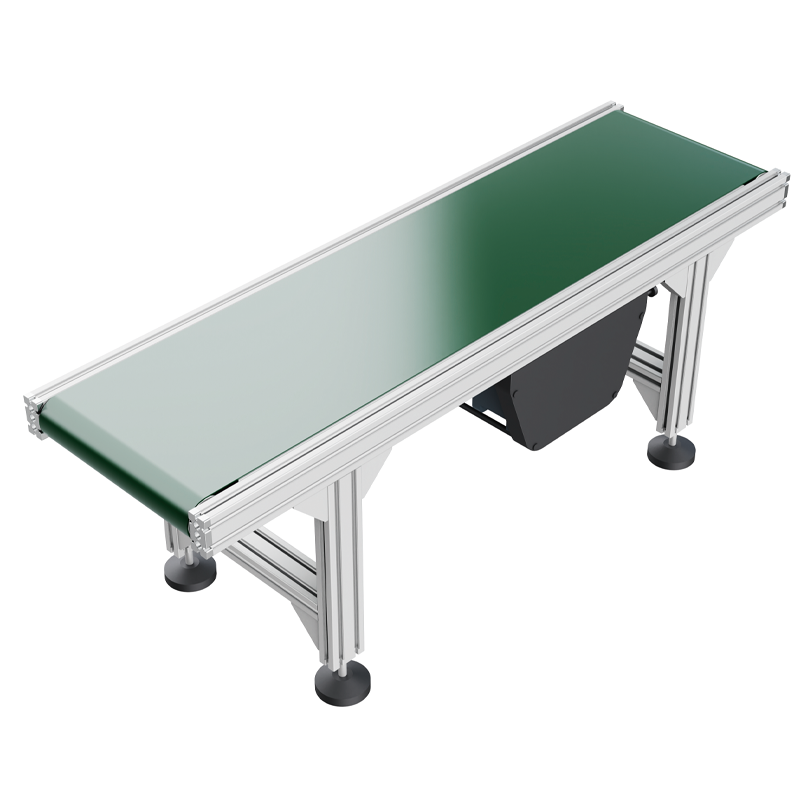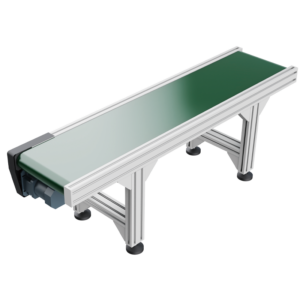Industrial belt conveyor system is very important for many fields. Our belt conveyor uses anodized 30 t slot and accessories for its main structure, and it looks clean, beaufical. The most important is that it is used for many factories.
Beschreibung
30 T Slot Aluminum Profile Belt Conveyor
Our economical industrial belt conveyor system is combined with slotted aluminum profiles for a low-profile, strong framework. Darüber hinaus, its foundation consists of a robust 30mm aluminum extrusion. While the aluminum system’s modular parts make for rapid assembly and simple modifications to meet any clients’ customizations.
And 30 belt conveyor is built with 30x30mm anodized aluminum profiles for maximum durability. Under the belt, a supportive structure of folded, modular galvanized steel ensures stability. Außerdem, standard features include 30mm diameter drive and tail rollers, with power supplied by an external shaft-mounted geared motor and an optional central drive.
In a word, we design it to handle up to 5kg per meter, and these conveyors also ensure precise belt movement with a tracking cleat positioned underneath.
Specifications:
Produktmerkmale:
- 30 series aluminum profiles and components, allowing easy integration with other complementary mechanisms like guardrails, sensors, usw.
- End-driven unit enabling unidirectional conveying with a maximum load capacity of 50KG.
- Simple and reliable structure with low maintenance;
- Recommended operational speed is below 20m/min. But exceeding this limit may reduce the product’s longevity.
- Available in fixed and adjustable widths. Then selectable as per specific requirements.
Dimensionsbeschreibung:

Classification of Belt Conveyors
Because the belt conveyor line is the most common conveyor equipment. So we can use it as a conveying component in non-standard equipment or independently. Darüber hinaus, independent equipment units can also be connected in series to form a multi-functional automated production line. So belt line design is the most basic design skill for mechanical design engineers.
Außerdem, belt line is also named belt-type assembly line, also called belt conveyor, belt conveyor or belt conveyor. As we can learn, it is a conveying way featured by belt drive. So it is an essential economical logistic conveying equipment. And it can form a rhythmic assembly line.
Classification:
1. Straight belt conveyor line;
2. Belt conveyor line with workbench;
3. Climbing belt conveyor line;
4. Turning belt conveyor line;
5. Trough belt conveyor line;
6. Telescopic belt conveyor line;
7. Knife edge belt conveyor line;
8. Side belt conveyor;
9. Round tube belt conveyor–new type
Basic Components and Principles
Different belt conveyors have some differences in structure, but their principles are the same. As you can see, the principle of the belt conveyor structure is shown in the picture:
- conveyor belt
- driven roller
- pallet or roller
- driving roller

1.Conveyor belt
And convey workpieces or materials. When the conveyor belt is running, the workpiece or material moves with the belt under the action of friction with the belt. So that the workpiece or material is transported from one location to another. So the upper belt needs to transport workpieces and is the load-bearing section. In other words, the lower belt does not work and is the return section.
2. Driving roller
Außerdem, it provides driving power, rotates under the drive of the motor. Next drives the belt to run through the friction between the drive roller and the belt.
3. Driven roller
There is no power roller, so the roller can rotate freely around the axis. So it works together with the driving roller, tensioning wheel, usw. to tighten the belt and maintain sufficient friction between the belt and the main driving roller.
4. Pallets or rollers
Then support the belt and workpieces or materials above the belt to prevent the belt from sagging. For occasions that require high flatness when the belt is running, a plate-shaped supporting plate is usually used under the belt conveying section. Otherwise, we can use a freely rotating roller. Since the return section of the belt does not carry workpieces, rollers are usually used for support at intervals.
Zusätzlich, the complete belt conveyor system also includes:
5. Positioning baffle
Since we keep the workpiece generally in a certain position when conveying the workpiece. And we can design positioning baffles or bars on both sides of the conveyor belt to keep the workpiece moving in a straight direction.
6. Tensioning mechanism
Since the belt will relax during movement, a tensioning mechanism is required to adjust the tension of the belt. As we know, the tensioning mechanism is also an indispensable mechanism for belt installation and removal.
7. Rack
Außerdem, we can design the belt line frame into various structural forms according to the usage requirements. According to the material category, we can divide it into profile frame and welded frame.
8. Motor drive system
The movement of the drive roller is driven by a motor, and a reducer usually decelerate it, then a gear drive drive it, chain drive or synchronous belt drive to drive the belt drive roller. In some cases, the motor is decelerated by a reducer and directly connected to the belt drive roller to save space. As shown in the picutre,
- workpiece;
- belt;
- baffle;
- motor;
- Reduzierer.
From a power point of view, it has fixed speed and adjustable speed; from the transmission direction. Darüber hinaus, we can divide it into one-way transmission and variable-direction transmission.

Usually, the load that a motor system can drive is in a limitation. For belt conveyor lines with a long length (for example, tens of meters), we usually use and splice multiple independent belt conveyor systems together in a straight line. That is, we fix and install the multiple independent belt conveyor systems on a conveyor line at the same height.
Main Technical Specifications
1. The main conveying forms are: strip workbench, independent workbench, unilateral workbench, double-sided workbench and no workbench conveyance form.
2. The driving modes include: motor driven conveying mode.
3. The common width of the belt is: 20~2000mm, and we can customize according to customer requirements.
4. The materials of conveyor belts include: rubber belts, PVC belts, canvas belts, food belts, usw.
5. The forms of conveyor belts include: conveyor belts with baffles, belts with enclosures, flat belts and anti-slip belts, usw.
6. The size of the workbench is determined by the user.
7. The work surface includes: fireproof board, ordinary rubber, anti-static rubber lamp.
8. Line body supports include: stainless steel, Aluminiumprofile, carbon steel spray-coated, usw.
9. The conveying speed is generally 0.1~10M/min; we can adopt speed regulation or fixed speed according to user needs.
10. Speed regulation includes: frequency conversion speed regulation, electromagnetic speed regulation, electronic speed regulation, mechanical speed regulation, usw.
11. The belt frame materials include: carbon steel, stainless steel, and aluminum profiles.
Besides aluminum profile belt conveyors, there are a big type. You can see that in the picture.


In a word, different belt conveyors have different applcation and load duty requrrements. So you could choose the suitable one according to your needs. If you have your mind and design drawing, there are professional engineers to customize best solutions for you. So please feel free to get a quote now. Then save your time, and get our start. In fact, we are waitng for you always.
Endlich, hope better and better business.





